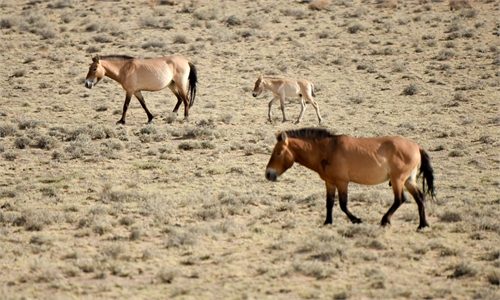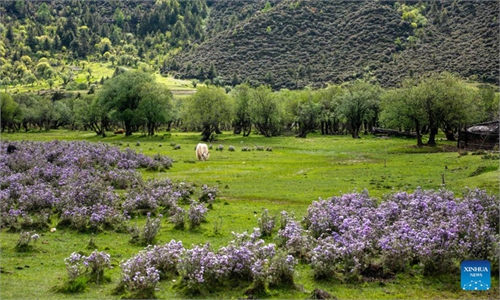
Photo taken by an infrared camera on May 26, 2022 shows a wild giant panda in the Giant Panda National Park's Tangjiahe area in southwest China's Sichuan Province.Photo:Xinhua
China will establish the world's largest national park system with more national parks to be built, Chinese authorities said on Wednesday, which marked the first anniversary of the establishment of the initial batch of national parks in the country, during which period the number of wild animals in the territories have greatly increased.
Substantive progress has been achieved in ecological protection of the five national parks since they were officially established on October 12, 2021, said the national park authorities.
The five parks - Northeast China Tiger and Leopard, Three-River-Source National Park, Giant Panda National Park, Wuyishan National Park and National Park of Hainan Tropical Rainforest - cover a total area of 230,000 square kilometers in 10 provinces, ranging from north to south China. They protect nearly 30 percent of state-level key species of wild animals and plants on land.
At least 28 new species of wildlife have been discovered in the National Park of Hainan Tropical Rainforest in the one year - nine new species of plants, six new species of animals and 13 new species of macrofungi, the Global Times learned from the park on Wednesday.
As the function of the rainforest ecosystem is gradually restored in the park, which sits in South China's Hainan Province, three new Hainan gibbons have been found in the past two years, and the wild population has increased to 36 in five groups.
In Northeast China, the national park cleared a migration route for Siberian tigers and leopards, with the populations of the two animals reaching more than 50 and 60, respectively.
Meanwhile, the Giant Panda National Park has ensured the effective protection of 72 percent of the wild giant pandas around China by connecting 73 separate natural reserves and 13 local habitats.
The Three-River-Source National Park has also seen a significant increase in the number of wild animals, such as Tibetan antelopes and Tibetan wild donkeys. The Wuyishan National Park in East China discovered 14 new species in the past three years.
Since their establishment, the five national parks have strengthened ecological protection and restoration and implemented the integration of monitoring from the "space, sky and land," realizing a unified management and scientific protection across regions and river basins, said Tang Xiaoping, director of the National Park Research Institute.
China plans to establish the world's largest national park system with about 50 selected national parks on the waiting list to be built, covering about 10 percent of China's total land area, according to China's National Forestry and Grassland Administration, reported CCTV on Wednesday.
The selected parks will protect China's most representative ecosystems and more than 80 percent of the state-level key protected wildlife species and their habitats.
Ecologically important areas, such as the Qinling Mountains and Yellow River Estuary, will be prioritized in creating and building national parks. A cluster of national parks will also be built on the Qinghai-Tibet Plateau, said Tang.
"China has an innate advantage in building a protected nature system with such parks as the main body due to the country's extremely rich variety of ecosystems on its vast territory," Zhang Jinshuo, deputy director of the Institute of Zoology under the Chinese Academy of Sciences, told the Global Times on Wednesday.
China officially established the first nature reserve in Dinghu Mountain, South China's Guangdong Province in 1956, and then started the construction of the system of protected natural areas, said Zhang.
The national parks will comprehensively ensure the preservation of the most critical and most valuable habitats of wildlife animals and thus effectively protect the country's biodiversity as a whole, he said.



